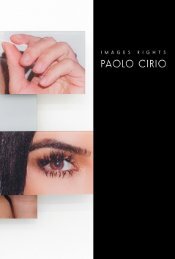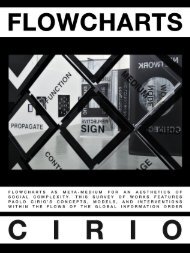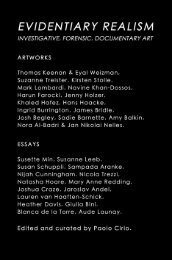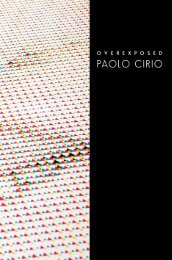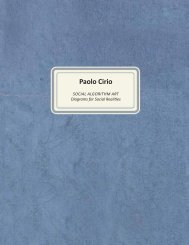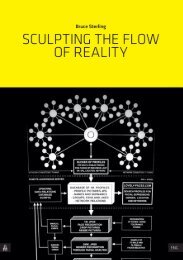FOUNDATIONS
A project by Paolo Cirio. Text by Lauren van Haaften-Schick. A RESEARCH PROJECT ON THE FOUNDATIONS OF THE AESTHETICS OF SOCIAL COMPLEXITY. Foundations reflects on the aesthetics and history of conceptual art concerning social complexity. Jack Burnham’s seminal defining of “systems aesthetics” in 1968, followed by the exhibitions Software at the Jewish Museum and Information at MoMA in New York in 1970, mark a turn in art addressing social and technological systems. Foundations focuses on the ontologies of conceptual art examining social fields, rather than solely the making of images, forms, or gestures driven by ideas. Informed by systems, cybernetics, and communication theories, this project reckons with today’s complexity in the age of algorithms, big data, and the Internet. This study and timelines by Paolo Cirio research on the genesis of the growing intersections among the domains of art, economics, politics, law, sociology, media, and technology.
A project by Paolo Cirio.
Text by Lauren van Haaften-Schick.
A RESEARCH PROJECT ON THE FOUNDATIONS OF THE AESTHETICS OF SOCIAL COMPLEXITY.
Foundations reflects on the aesthetics and history of conceptual art concerning social complexity. Jack Burnham’s seminal defining of “systems aesthetics” in 1968, followed by the exhibitions Software at the Jewish Museum and Information at MoMA in New York in 1970, mark a turn in art addressing social and technological systems. Foundations focuses on the ontologies of conceptual art examining social fields, rather than solely the making of images, forms, or gestures driven by ideas. Informed by systems, cybernetics, and communication theories, this project reckons with today’s complexity in the age of algorithms, big data, and the Internet. This study and timelines by Paolo Cirio research on the genesis of the growing intersections among the domains of art, economics, politics, law, sociology, media, and technology.
Create successful ePaper yourself
Turn your PDF publications into a flip-book with our unique Google optimized e-Paper software.
<strong>FOUNDATIONS</strong><br />
By Paolo Cirio
I see the project Foundations as a study<br />
into the aesthetics of social complexity.<br />
In framing this study, I looked at both the<br />
historical and aesthetic foundations of<br />
art that considered how information and<br />
communication systems had begun to<br />
transform the world as we know it. Beginning<br />
in the early sixties, the advancement of<br />
mass media and the first computational<br />
machines began to reorganize society. As a<br />
result, the structures of economy, politics,<br />
and culture began to increase in complexity<br />
and interdependency, forming interrelated<br />
networks of social processes and systems.<br />
Fifty years ago saw the introduction of<br />
the first electronic money transfers, world<br />
trade agreements, real time news networks,<br />
clustering of databases, and the end of<br />
the gold standard. Around the same time,<br />
the rising of the counterculture, civil and<br />
labour rights movements were amplified by<br />
new accessible media for the distribution<br />
of information and related critical semiotic<br />
theories. Artists began to respond by<br />
questioning the shaping and configuration of
systems forming social complexity, through<br />
a variety of fields and interests, such as<br />
working with linguistic, financial, and<br />
cultural systems, ultimately expanding the<br />
conventions of modern art.<br />
Centered around the defining of “systems<br />
aesthetics” in 1968, and the following<br />
exhibitions Information at MoMA and<br />
Software at the Jewish Museum in 1970 in<br />
New York, many connected art moments can<br />
be viewed as symptomatic of the emergence<br />
of new paradigms of social complexity. As<br />
such, the timeline published here is the<br />
result of my research into this history, and<br />
it should be read like a curated exhibition<br />
and aesthetics theory that take the form of<br />
a publication and an artwork.<br />
During my research, I wanted to move<br />
away from the general and vague notion of<br />
conceptual art, as well as art and technology,<br />
instead looking only at art that reflected on<br />
the social implications of information systems.<br />
Thus, I excluded minimal art, and much of<br />
the conceptual art most often associated<br />
with artists such as Sol LeWitt, whose work
is focused more on the making of visual<br />
forms with information. I have also excluded<br />
computer art, kinetic art, and work merely<br />
concerned with science and technology<br />
as material or for the making of graphic or<br />
sound forms. This research specifically<br />
looks at the aesthetics that expanded the<br />
concerns and materials of art into the social<br />
processes forming society. The full timeline<br />
in this publication however is extended to<br />
include pivotal art moments that introduced<br />
mediums and areas of interest.<br />
My methodology for this research consisted<br />
of looking for any component in artworks<br />
or artists’ practice, exhibitions, and<br />
publications that refer to any social field or<br />
process affected by information systems,<br />
including economy, law, sociology, art, and<br />
media. This is how I then refined the final<br />
charts with a selection of key moments from<br />
fifty years ago.<br />
The chart is my curatorial and research<br />
mental process, a network of art references<br />
that are interconnected by fields, aesthetic<br />
qualities, and similar characters. These are
for me the foundations of art that define an<br />
aesthetics of social complexity and related<br />
artist practices for the last fifty years.<br />
Considered in retrospect, that moment of art<br />
history has a significance that goes beyond<br />
systems, technology, or dematerialization,<br />
showing us the beginning of a new phase<br />
of modernism, and yet this history is still<br />
being shaped. Inevitably, this timeline is<br />
incomplete and this project is only an initial<br />
study to delineate an aesthetics theory and<br />
history that would need more research and<br />
articulation. Meanwhile, the idea is now<br />
available to anyone, with these timelines and<br />
reflections, other forms of interpretations<br />
can further this research and theory.<br />
Introductory text by Paolo Cirio.<br />
Spring 2019.
EXPANDING<br />
SYSTEMS:<br />
ART,<br />
INFORMATION<br />
AND SOCIAL<br />
SYSTEMS IN<br />
THE 1960s-70s<br />
By Lauren van Haaften-Schick
Radical changes in the processing and<br />
transmission of information in the 1960s<br />
and 70s opened up new avenues for artistic<br />
experimentation, and also introduced<br />
the reorganization of industry, finance<br />
capitalism, and governance in general.<br />
Rapid developments in computing and<br />
communication technologies made landmark<br />
innovations like space travel a reality,<br />
but also sped up transactions in banking,<br />
investment, and global trade, ushering in<br />
unprecedented frontiers of financialization. 1<br />
New capabilities for dissemination made<br />
possible via the Xerox machine sparked a<br />
surge of challenges to established exhibition<br />
models as artists experimented with the<br />
“quick, cheap, and easy” printing and copying<br />
technology 2 ; in parallel, the new speed and<br />
simplicity of reproduction also encouraged<br />
tighter copyright restrictions. Accelerated<br />
statistical modeling enabled a war guided by<br />
numbers, where data – and the information<br />
feeding it and which it generated – could be<br />
manipulated for political gain; simultaneously,<br />
artist-activists tabulated numbers for a<br />
very different political mission of exposing
prejudice and exclusion by art institutions. 3<br />
Protests in favor of artists’ rights laws<br />
surged alongside artistic experimentation<br />
with law as medium, so that at the same time<br />
artists called for greater recognition by the<br />
legal system, they also sought to undermine<br />
and interrogate its authority. 4 None of these<br />
layered and contradictory developments<br />
occurred in isolation, and each informed, or<br />
were informed by struggles for class, gender,<br />
and racial equality, the anti-war movement,<br />
and an overall critical interest in what<br />
information could mean and do. Against this<br />
backdrop, artworks, the work of being an<br />
artist, and living in the world as a working<br />
artist, could no longer be considered to be<br />
independent positions or phenomenon, but<br />
only in relation to other systems.<br />
As Jack Burnham wrote in his seminal essay<br />
Systems Esthetics of 1968, the 1960s marked<br />
the transition from an “object-oriented to a<br />
systems-oriented culture” wherein change<br />
ceased to be understood as emanating “from<br />
things,” and instead came to been seen as<br />
generated or perpetuated by “the way things<br />
are done.” 5 For Burnham, “any situation,
either in or outside the context of art, may<br />
be designed and judged as a system,” and a<br />
system may contain “people, ideas, messages,<br />
atmospheric conditions, power sources, etc.” 6<br />
in varying degrees of order. Here, events and<br />
objects cannot be considered autonomous,<br />
but are instead observed for their points of<br />
interaction and intersection. At the same<br />
time, as in the realm of cybernetics, systems<br />
operate by virtue of their interdependent<br />
processes, self-propelling endurance and<br />
regeneration.<br />
In a sense, systems measure the world and<br />
reflect it back to itself. What is measured,<br />
how methodologies are conceived and<br />
deployed, and what that reflection reproduces<br />
– or suppresses – has invited (necessitated<br />
even) artistic critique and intervention. For<br />
many curators at the time, this inspired an<br />
interest in computing and emergent means of<br />
communication, and in creating exhibitions<br />
that put the limits and potentials of information<br />
technologies on display. Central examples<br />
include David Katzive’s Art By Telephone at<br />
the Museum of Contemporary Art in Chicago<br />
in 1969 where instructions for artwork
fabrication were transmitted telephonically<br />
and then also exhibited, Kynaston McShine’s<br />
Information at MoMA in 1970 featuring artists<br />
grappling with the zeitgeist term through a<br />
variety of documentary and communication<br />
techniques, and Software at the Jewish<br />
Museum in 1970, curated by Burnham,<br />
for which artists were invited to test the<br />
capacities of new computing systems – often<br />
over-loading them in the process.<br />
Many artists (who outnumber the curators<br />
and institutions in this history) deployed<br />
a systems approach by taking up the logic<br />
and language of sociological data to assess<br />
the social landscape of the art world, as<br />
in Stephen Willats’ 1967 Notice, a quasimanifesto<br />
proposing a turn towards “outgoing<br />
socially concerned art,” Hans Haacke’s series<br />
of Gallery Visitor’s Profile works beginning in<br />
1971 that surveyed the lifestyles and political<br />
leanings of art-viewing audiences, and Adrian<br />
Piper’s Context series of 1970 for which the<br />
artist collected clippings, conversational<br />
snippets, and invited the public to contribute<br />
comments on the state of the relationship<br />
between art, political movements, and the
space of exhibitions. 7 Haacke’s and Piper’s<br />
works took their final form as charts, graphs,<br />
publications, notebooks, and assembled<br />
documents – the visual and material tropes<br />
most readily associated with “systems<br />
aesthetics.” And yet it is key to remember that<br />
the information these works recorded was far<br />
from static. In fact, they documented actions<br />
and social landscapes operating in real-time,<br />
which were very much alive. This reminds us<br />
too that data does not end with numbers on a<br />
page, but exists in order to record processes<br />
and conditions in their evolution. In Marshall<br />
McLuhan and Quentin Fiore’s terms, such<br />
artworks expose the “active processes” and<br />
the “pervasive structure” of environments,<br />
which are typically invisible, thus providing<br />
a means of direct attention and enabling<br />
us to see and understand those processes<br />
more clearly. 8 For these artists and theorists,<br />
illuminating those processes in the right way,<br />
in the right place, and at the right time, could<br />
have material and social effects. 9<br />
This strand of art investigating social<br />
systems, and its overlap with conceptual art<br />
and institutional critique, also came hand in
hand with a livened interest among artists<br />
in interrogating the economic, political, and<br />
legal systems that their artwork – and which<br />
they as artists – came in contact with once<br />
participating in the art market and cultural<br />
institutions. Robert Smithson stated in an<br />
interview in 1972 that artists were now<br />
beginning to turn their interest towards “the<br />
investigation of the apparatus the artist is<br />
threaded through.” 10 Taking up Smithson’s cue,<br />
we might shift our attention away from the<br />
object of art towards that which is “beyond the<br />
frame,” to use Craig Owens’ term, leading us<br />
back to Burnham’s description that a systems<br />
approach rejects “contrived confines such<br />
as the theater proscenium or picture frame.”<br />
Rather than viewing devices such as “the<br />
frame” as an enclosure that silos our attention<br />
on the object inside it, a systems lens instead<br />
illuminates the background processes and<br />
network of relations that an artwork passes<br />
through and which its value is dependent<br />
upon. Or, as McLuhan and Fiore asserted, “no<br />
detachment or frame” is even possible in the<br />
wake of high-speed “informational media,”<br />
and its total world re-ordering, for it “involves<br />
all of us, all at once.” 11
But because we are all entrenched in<br />
informational and media systems – threaded<br />
through them, as it were – does that mean that<br />
we also have the ability to direct the course of<br />
their flow? For McLuhan and Fiore, “there is no<br />
inevitability as long as there is a willingness<br />
to contemplate what is happening.” 12 At<br />
the same time, an understanding of social<br />
and cultural change is “impossible without<br />
a knowledge of the way media work as<br />
environments,” or without a sensitivity to<br />
and grasp of the elements and machinations<br />
of a system. 13 The timeline printed alongside<br />
this brief essay lists some relevant artworks,<br />
exhibitions, and publications that attempted<br />
to make sense of systems and our positions<br />
within and in relation to them, or at the very<br />
least, threw their existence into relief. The<br />
project remaining for the reader is to fill in<br />
the missing historical gaps, but more so,<br />
to pull these references into the present in<br />
order to reflect on the social systems we find<br />
ourselves threaded through today.<br />
Text by Lauren van Haaften-Schick.<br />
Summer 2019.
1 Wyatt Wells, “Certificates and Computers: The Remaking of Wall<br />
Street, 1967 to 1971,” Business History Review; Boston 74, no. 2<br />
(Summer 2000): 193–235.<br />
2 Michel Claura and Seth Siegelaub, “L’art conceptuel,” XXe siècle<br />
35, no. 41 (December 1973): 156–59; Lucy R. Lippard, “Postface,”<br />
in Six Years: The Dematerialization of the Art Object from 1966<br />
to 1972, Reprint edition (Berkeley: University of California Press,<br />
1997), 263–64.<br />
3 Such groups include Women Artists in Revolution (WAR), Women<br />
Students and Artists for Black Art Liberation (WSABAL), and the<br />
Los Angeles Council of Women Artists (LACWA), among others. See<br />
generally: Julia Bryan-Wilson, Art Workers: Radical Practice in the<br />
Vietnam War Era (Berkeley: University of California Press, 2009),<br />
127-172; Susan Cahan, Mounting Frustration: The Art Museum in the<br />
Age of Black Power (Durham: Duke University Press, 2016).<br />
4 See generally: Joan Kee, Models of Integrity: Art and Law in Post-<br />
Sixties America (Oakland: University of California Press, 2019).<br />
5 Jack Burnham, “Systems Esthetics,” Artforum 7, no.1 (1968): 31.<br />
6 Burnham, “Systems Esthetics,” 32.<br />
7 See: Hans Haacke, Framing and Being Framed: 7 Works, 1970-<br />
75 (Halifax: Press of the Nova Scotia College of Art and Design,<br />
1975), 13-58; Stephen Willats, Notice, 1967, typescript. http://<br />
stephenwillats.com/texts/notice-1967/; John Parish Bowles, Adrian<br />
Piper: Race, Gender, and Embodiment (Durham: Duke University<br />
Press, 2011), 137-161.<br />
8 Marshall McLuhan and Quentin Fiore, The Medium Is the Massage<br />
(New York: Random House, 1967), 68.<br />
9 As Hans Haacke summarized in an interview from 1971,<br />
“Information presented at the right time and in the right place can<br />
be potentially very powerful. It can affect the general social fabric.”<br />
Jeanne Siegel, “An Interview with Hans Haacke,” in Conceptual<br />
Art: A Critical Anthology, ed. Alexander Alberro and Blake Stimson<br />
(Cambridge, Mass.: The MIT Press, 2000), 244.<br />
10 Bruce Kurtz, “Conversation with Robert Smithson (1972),” in<br />
Robert Smithson, The Collected Writings, by Robert Smithson,<br />
ed. Jack D. Flam (Berkeley: University of California Press, 1996),<br />
262–69. Quoted in Craig Owens, “From Work to Frame, or Is There<br />
Life After ‘The Death of the Author?,’” in Beyond Recognition:<br />
Representation, Power, and Culture (Berkeley: University of<br />
California Press, 1992), 122.<br />
11 Marshall McLuhan and Quentin Fiore, The Medium Is The<br />
Massage (New York: Random House, 1967), 53.<br />
12 McLuhan and Fiore, The Medium Is The Massage, 25.<br />
13 Ibid, 26.
TIMELINES
EXHIBITIONS
1962, Arte Programmata<br />
Exhibition curated by Bruno<br />
Munari and Giorgio Soavi at<br />
Olivetti Showroom, Milan<br />
1966, Primary Structures<br />
Exhibition curated by<br />
Kynaston McShine at the<br />
Jewish Museum,<br />
New York<br />
1966, 9 Evenings: Theatre<br />
and Engineering<br />
First performance by<br />
Experiments in Art<br />
and Technology (E.A.T)<br />
at the 69th Regiment<br />
Armory, New York<br />
1967, Arte Povera/Im Spazio<br />
Exhibition curated by<br />
Germano Celant at La<br />
Bertesca Gallery, Genoa
1968, Cybernetic<br />
Serendipity<br />
Exhibition by Jasia<br />
Reichardt at the Institute of<br />
Contemporary Arts London<br />
1968, Visual Automatics &<br />
Visual Transmitters<br />
Solo exhibition by Stephen<br />
Willats at Oxford Museum of<br />
Modern Art, UK<br />
1969, When Attitudes<br />
Become Form<br />
Exhibition curated by Harald<br />
Szeemann at Kunsthalle<br />
Bern, Krefeld and ICA<br />
London<br />
1969, Number 7, Benefit for<br />
Art Workers Coalition (A.W.C.)<br />
Exhibition by Lucy R.<br />
Lippard at Paula Cooper<br />
Gallery, New York
1969, Konzeption/<br />
Conception<br />
Exhibition curated by<br />
Konrad Fischer and Rolf<br />
Wedewer at Städische<br />
Museum, Leverkusen<br />
1969, Hans Haacke<br />
Exhibition of ‘systems’<br />
works at Howard Wise<br />
Gallery, New York<br />
1969, Art by Telephone<br />
Exhibition curated by David<br />
H. Katzive at Museum of<br />
Contemporary Art, Chicago<br />
1970, Information<br />
Exhibition curated by<br />
Kynaston McShine<br />
at the Museum of Modern<br />
Art, New York
1970, Software<br />
Exhibition curated by Jack<br />
Burnham at the Jewish<br />
Museum, New York<br />
1970, Conceptual Art, Arte<br />
Povera, Land Art<br />
Exhibition curated by<br />
Germano Celant at the GAM<br />
Museum, Turin<br />
1971, Art & Economics<br />
Exhibition curated by Artist<br />
Placement Group at the<br />
Hayward Gallery, London
ARTWORKS
1914, The Network of<br />
Stoppages<br />
Artwork by Marcel Duchamp<br />
1924, Monte Carlo Bond<br />
Artwork by Marcel Duchamp<br />
1956, Cybernetic Sculptures<br />
Artwork by Nicolas Schöffer<br />
1959, Art Society Feedback<br />
Artwork By Willats Stephen<br />
1964, Invitation to Moi<br />
aussi, je me suis demandé<br />
si je ne pouvais pas vendre<br />
quelque chose et réussir<br />
dans la vie... Galerie Saint<br />
Laurent<br />
Artwork by Marcel<br />
Broodthaers
1965, Auto-Destructive<br />
Momentum<br />
Artwork by Gustav Metzger<br />
1966, The First Work of<br />
Media Art<br />
Artwork by Group of Mass<br />
Media Art<br />
1966, March 31, 1966<br />
Artwork by Dan Graham<br />
1966, Date Paintings<br />
Artworks by On Kawara<br />
1966, Artist Placement<br />
Group (A.P.G.)<br />
Formed by Barbara Steveni<br />
and John Latham, London<br />
1968, Creative Collaboration<br />
Work by Michelangelo<br />
Pistoletto at the Venice<br />
Biennale
1968, Department of Eagles<br />
Work by Marcel Broodthaers<br />
1968, The Hypothesis Series<br />
Artwork by Adrian Piper<br />
1968, Ciclo de Arte<br />
Experimental<br />
The Rosario Group,<br />
Argentina<br />
1969, Profit Systems One<br />
Artwork by Les Levine<br />
1969, Following Piecet<br />
Artwork by Vito Acconci<br />
1969, Transference: Roget’s<br />
Thesaurust<br />
Publication by Vito Acconci<br />
1969, News<br />
Artwork by Hans Haacke
1969, Money<br />
Artwork by Hans Haacke<br />
1969, Art Workers Coalition<br />
(A.W.C.)<br />
Organization formation<br />
1969, Che Fare?<br />
Artwork by Mario Merz<br />
1969, Total Positivity<br />
Artwork by Bernar Venet<br />
1970, Context<br />
Series of artworks by Adrian<br />
Piper<br />
1970, The Seventh<br />
Investigation, Preposition one<br />
Artwork by Joseph Kosuth<br />
1970, Dialectic Triangulation<br />
Artwork by Agnes Denes
1970, Information, No Theory<br />
Artwork by Christine Kozlov<br />
1970, Insertions into<br />
Ideological Circuits<br />
Artwork by Cildo Meireles<br />
1970, Das Kapital Raum<br />
Artwork by Joseph Beuys<br />
1970, Variable Piece No. 70<br />
Douglas Huebler<br />
1970, Peripatetic Artists<br />
Guild (P.A.G.)<br />
Project by Robert Morris<br />
1970, Information Action<br />
Artwork by Joseph Beuys
1971, Shapolsky et al.<br />
Manhattan Real Estate<br />
Holdings, a Real-Time Social<br />
System, as of May 1, 1971<br />
Artwork by Hans Haacke<br />
1971, Arte Vida<br />
Artwork by Muntadas<br />
1971, An Incomplete<br />
Examination of the Highway<br />
Network/User/Perceiver<br />
Systems<br />
Artwork and essay by Alice<br />
Aycock<br />
1971, The Artist’s Reserved<br />
Rights Transfer and Sale<br />
Agreement<br />
Project by Robert Projansky<br />
and Seth Siegelaub
1972, Preliminary Statement<br />
Text by Don Celendar for his<br />
“movements” series<br />
1972, John Weber Gallery<br />
Visitors’ Profile 1 and 2<br />
Artwork by Hans Haacke
PUBLICATIONS
1950, The Human Use of<br />
Human Beings<br />
Book by Norbert Wiener<br />
1960, Exploration in<br />
Communication<br />
Book by Marshall McLuhan<br />
and Edmund Carpenter<br />
1961, Computers and<br />
Common Sense<br />
Book by Taube Mortimer<br />
1962, Gutenberg Galaxy<br />
Book by Marshall McLuhan<br />
1964, The Technological<br />
Society<br />
Book by Ellun Jacques<br />
1964, Information Theory<br />
Book by Gordon Raisbeck
1964, The Artworld<br />
Essay by Arthur Danto<br />
1965, Control Magazine<br />
First issue by Stephen Willats<br />
1967, Society of the Spectacle<br />
Publication by Guy Debord<br />
1967, The New Industrial<br />
State<br />
Book by J. K. Galbraith<br />
1967, Behaviorist Art and the<br />
Cybernetic Vision<br />
Essay by Roy Ascott<br />
1967, Notice<br />
Text by Stephen Willats<br />
1967, E.A.T. Newsletter<br />
First issue of the publication<br />
in New York
1967, The Value of Didactic Art<br />
Essay by Barbara Rose for<br />
ArtForum<br />
1968, The Dematerialization<br />
of Art<br />
Essay by Lucy R. Lippard<br />
and John Chandler for Art<br />
International<br />
1968, Che Fare/Bollettino<br />
di Critica e Azione<br />
d’Avanguardia<br />
First issue of the journal in<br />
Italy<br />
1968, Systems Esthetics<br />
Essay by Jack Burnham for<br />
ArtForum<br />
1968, The Whole Earth<br />
Catalogue<br />
First issue of the magazine<br />
in the United States
1968, Art-Society System<br />
Essay by Victor Burgin in<br />
Control magazine, no. 4<br />
1968, The Xerox Book<br />
Publication by Seth<br />
Siegelaub and Jack Wendler<br />
1968, Statements<br />
Book by Lawrence Weiner<br />
1968, The McLuhan DEW-Line<br />
Series of publication by<br />
Marshall McLuhan<br />
1968, Information Theory<br />
and Esthetic Perception<br />
Book by Moles Abraham<br />
1969, Arte Povera<br />
Publication by Germano<br />
Celant
1969, Reflection on the<br />
Technocratic Society and<br />
its youthful opposition<br />
Book by Roszak Theodore<br />
1969, Utopia or Oblivion:<br />
The Prospect for Humanity<br />
Book by Buckminster Fuller<br />
1969, March 1969 [One<br />
Month]<br />
Catalogue exhibition by<br />
Seth Siegelaub<br />
1969, Real Time Systems<br />
Essay by Jack Burnham for<br />
ArtForum<br />
1969, Declaration of Intent<br />
Text by Lawrence Weiner<br />
1969, Art After Philosophy<br />
Essay by Joseph Kosuth
1969, Art-Language: The<br />
Journal of Conceptual Art<br />
First issue of the magazine<br />
in the UK<br />
1970, Money for Money’s<br />
Sake<br />
Essay by Jean Lipman for<br />
Art in America<br />
1970, Function<br />
Series of books by Joseph<br />
Kosuth, Turin<br />
1970, Radical Software<br />
First issue of the magazine<br />
in the United States<br />
1971, The Structure of Art<br />
Book by Jack Burnham<br />
1971, Changing: Essays in<br />
Art Criticism<br />
Book by Lucy R. Lippard
BRIEF BIBLIOGRAPHY<br />
OF THE TIMELINES<br />
Information by Kynaston L. McShine<br />
MoMA catalogue, 1970<br />
Six Years by Lucy R. Lippard<br />
University of California, 1973<br />
Systems by Edward A. Shanken<br />
Whitechapel: Documents of<br />
Contemporary Art, 2015<br />
Various material from<br />
Paolo and Lauren
QUOTES
“Already in California think-tanks and in<br />
the central planning committees of each<br />
soviet, futurologists are concentrating on<br />
the role of the technocracy, that is, its<br />
decision-making autonomy, how it handles<br />
the central storage of information, and the<br />
techniques used for smoothly implementing<br />
social change. In the automated state power<br />
resides less in the control of the traditional<br />
symbols of wealth than in information.”<br />
Jack Burnham in Systems Esthetics from<br />
Artforum, 1968
“At the basic level artists are similar to<br />
programs and subroutines. They prepare<br />
new codes and analyze data in making<br />
works of art. …Emotionally most humanists<br />
share an instinctive antipathy for these<br />
immensely complex computer systems.<br />
Their Orwellian overtones far overshadow<br />
their conceivable use as artists’ tools. But<br />
practically, it is imperative that artists do<br />
understand them - both technically and<br />
philosophically.”<br />
Jack Burnham in Real Time Systems, 1969
“Art ‘lives’ through influencing other art,<br />
not by existing as the physical residue of<br />
an artist’s ideas. The reason that different<br />
artists from the past are ‘brought alive’<br />
again is because some aspect of their work<br />
becomes ‘usable’ by living artists.”<br />
Joseph Kosuth in Art After Philosophy, 1969
“Artwork may also trigger off responses of a<br />
polemical or social kind, encouraging their<br />
audience changes in individual or group<br />
behavior by questioning preconceptions,<br />
destroying illusions by means of the shock of<br />
unfamiliar, absurd or incongruous imagery. ”<br />
Roy Ascott in The Cybernetic Stance, 1968
“For the artist a move away from the<br />
inverted qualities of art today (epitomized<br />
in the abstract coding of wall painting)<br />
towards an outgoing socially concerned<br />
art offers a new potential for making<br />
politically relevant art practice. This<br />
development coupled with information<br />
drawn from modern information areas, such<br />
as psychology, communication theory, etc.,<br />
leaves the artist in a position to look at such<br />
important issues as audience composition,<br />
and the relevance of concerns in art to<br />
their motivations. The idea of art as known<br />
at present could then well disappear<br />
altogether, and could be replaced by an art<br />
which structured to function as an integral<br />
part of the environment.”<br />
Stephen Willats in Notice, 1967
“Information presented at the right time and<br />
in the right place can be potentially very<br />
powerful. It can affect the general social<br />
fabric. Such things go beyond established<br />
high culture as it has been perpetrated by<br />
a taste-directed art industry. Of course<br />
I don’t believe that artists really wield<br />
any significant power. At best, one can<br />
focus attention. But every little bit helps.<br />
In concert with other people’s activities<br />
outside the art scene, maybe the social<br />
climate of society can be changed. Anyway,<br />
when you work with “real stuff” you have<br />
to think about potential consequences.”<br />
Hans Haacke in the interview on Arts, 1971
COPYRIGHTS<br />
All copyrights belong to the respective authors.<br />
All texts and images published courtesy of the<br />
authors. This first edition of this artist book<br />
was published in 2019 by Paolo Cirio Studio.<br />
LICENCE<br />
Creative Commons, Attribution<br />
NonCommercial ShareAlike 4.0<br />
ISBN FOR DISTRIBUTION<br />
ISBN 978-0-359-88956-3 90000<br />
9<br />
780359<br />
889563




